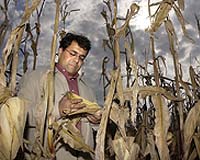 |
Kathmandu, Nepal (UPI) Aug 31, 2010 Nepal, already struggling with high levels of malnutrition and food insecurity, could see its harvests cut in half this year due to late monsoon rains, the World Food Program says. Of particular concern, said Dominique Hyde, deputy country director of WFP in Nepal, is the mid and far western area of the country, home to 600,000 of the country's estimated 3.6 million people who are considered food insecure. Hyde noted that there have been three droughts since 2006 and now the region is experiencing an erratic monsoon, which she attributed to climate change. "We're expecting a 30-50 percent loss of harvest because of this year's monsoon," Hyde said, reports IRIN, the news agency of the United Nations Office for the Coordination of Humanitarian Affairs. The mid-western Karnali region -- considered the poorest, least developed and most food insecure part of Nepal -- has the highest levels of malnutrition in the country. Nearly 70 percent of children under 5 years old have stunted growth and nearly half are underweight, WFP says. Because Karnali lacks proper irrigation and landslides frequently block the main road, its rain-fed production usually only provides the local population with enough food to last half a year or less. "You have people who have been trying to deal with drought over the past three to four years, and have depleted their assets," said Hyde. "What do they do? How do they cope? They have used most of their assets, so they pull their children out of school. They send their relatives to India, so it's one less mouth to fill." To tackle Nepal's limited agricultural output, the U.N. Development Program has suggested increasing irrigation projects, making better use of seeds, fertilizers and pesticides as well as addressing the effects climate change and deforestation. WFP and the Nepali government's Poverty Alleviation Fund signed a memorandum of understanding Sunday to form a strategic alliance aimed at alleviating poverty and food insecurity in the mid to far-western regions. "The partnership is about two organizations with significant on-the-ground capacity and experience joining hands to effectively reach the most vulnerable and isolated communities in the country," said Vidyadhar Mallik, vice chairman of PAF, The Hindustan Times reports. Although Nepal's government signed over a $36 million World Bank grant to WFP this month, it still is $21 million short, Hyde said, and the organization plans to scale back from serving 22 districts to 16 districts in November. If WFP doesn't receive additional funds, it will have to further decrease its scope to 10 districts.
Share This Article With Planet Earth
Related Links Farming Today - Suppliers and Technology
 Growing Drought-Tolerant Crops Inching Forward
Growing Drought-Tolerant Crops Inching ForwardMilwaukee WI (SPX) Aug 31, 2010 A collaborative team of scientists led by researchers at The Medical College of Wisconsin, in Milwaukee, has used the tools of structural biology to understand how a synthetic chemical mimics abscisic acid (ABA), a key stress hormone that helps plants cope with adverse environmental conditions such as drought. The results are published online in Nature Structural and Molecular Biology in a ... read more |
|
| The content herein, unless otherwise known to be public domain, are Copyright 1995-2010 - SpaceDaily. AFP and UPI Wire Stories are copyright Agence France-Presse and United Press International. ESA Portal Reports are copyright European Space Agency. All NASA sourced material is public domain. Additional copyrights may apply in whole or part to other bona fide parties. Advertising does not imply endorsement,agreement or approval of any opinions, statements or information provided by SpaceDaily on any Web page published or hosted by SpaceDaily. Privacy Statement |